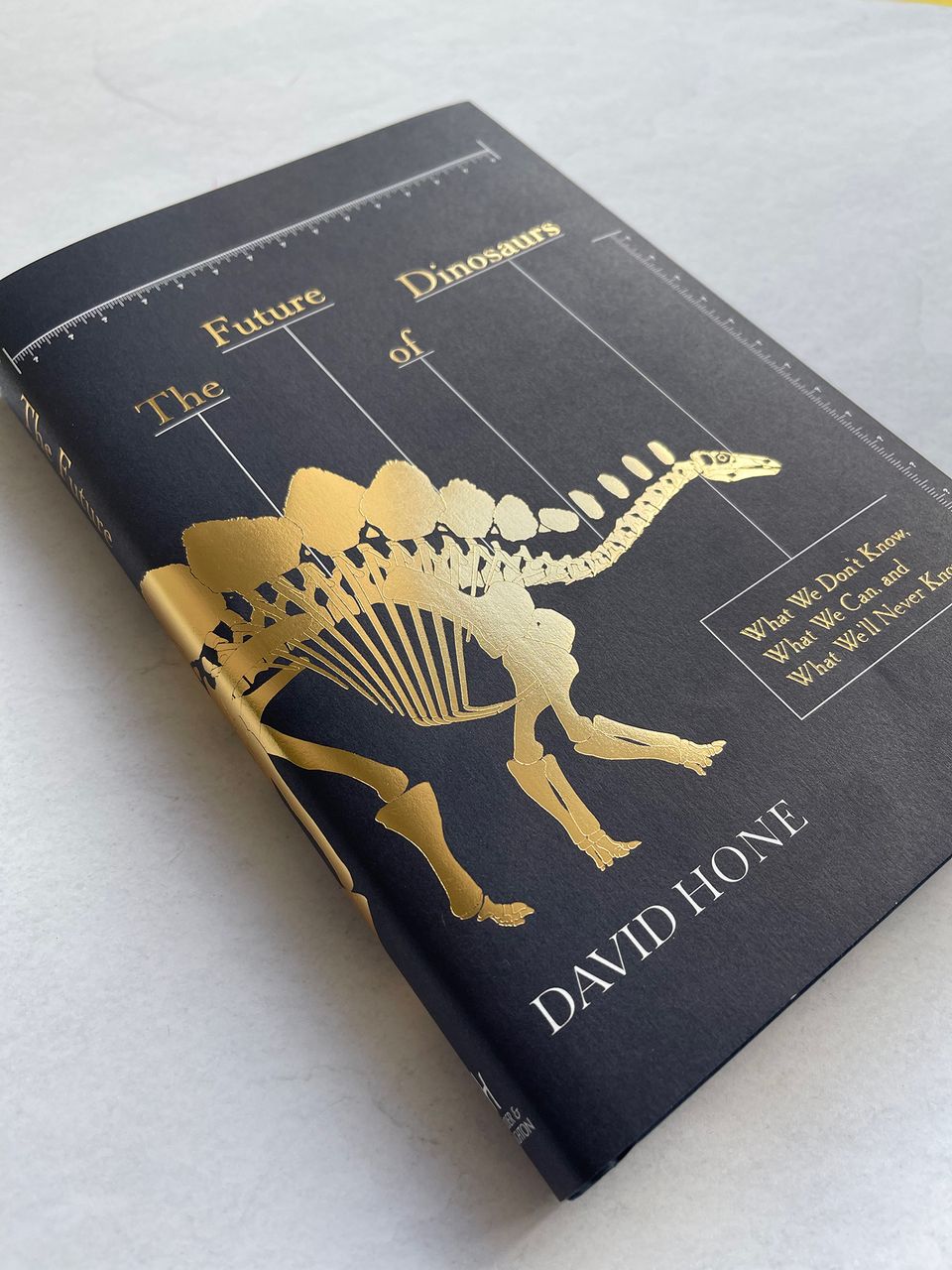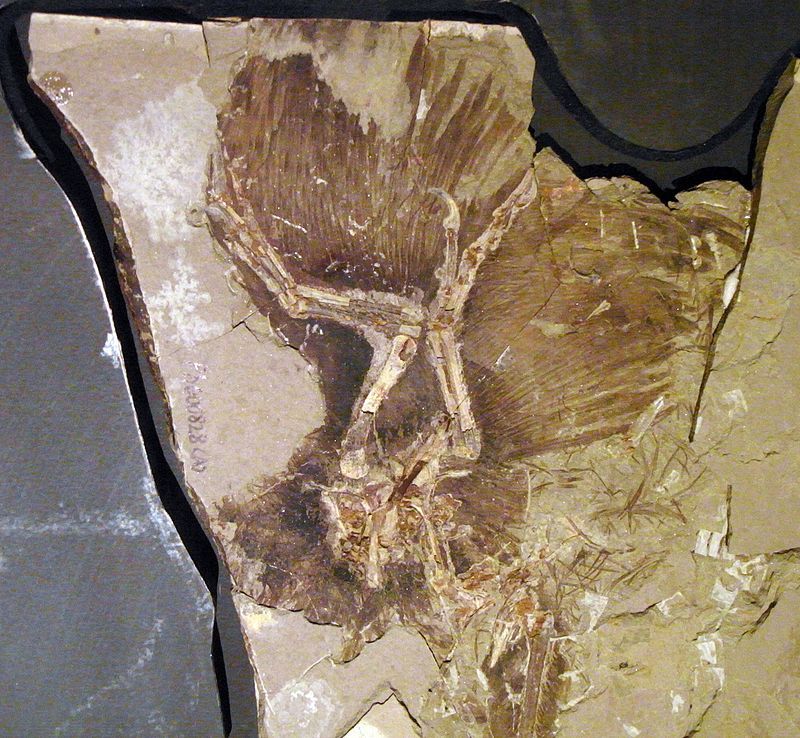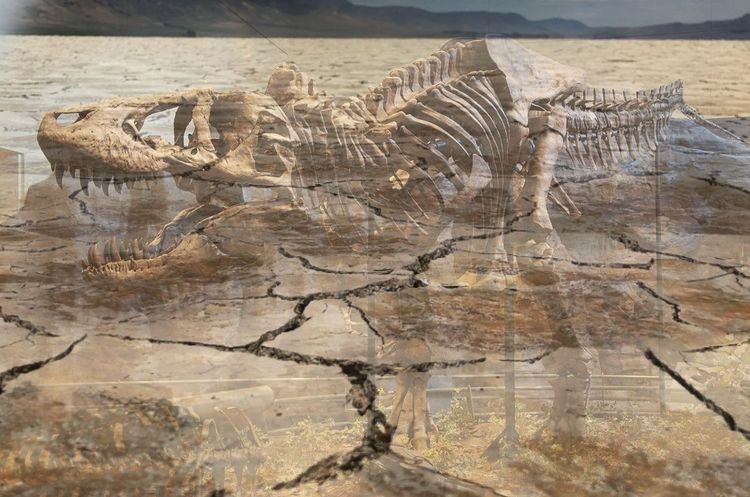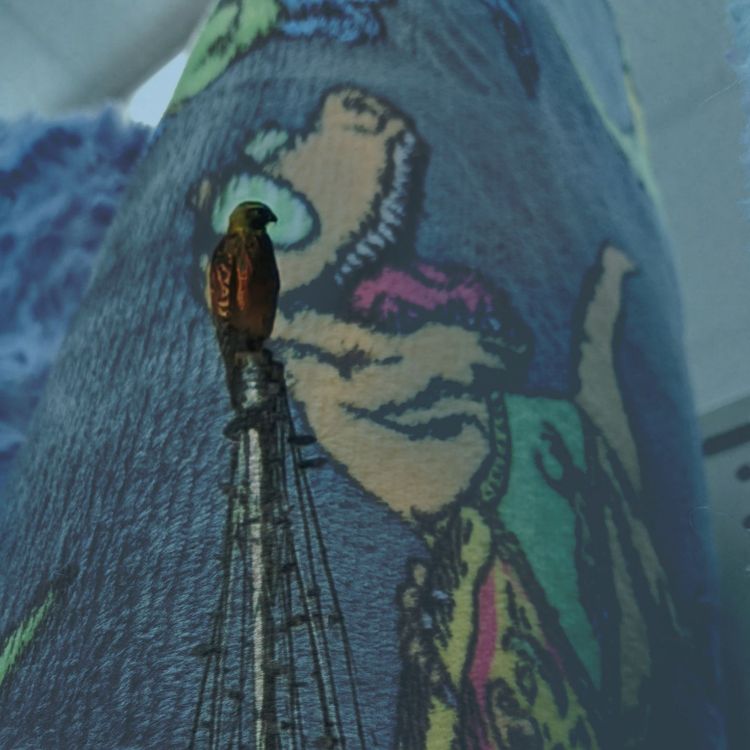The Future of Dinosaurs: An Interview With Dr. David Hone

Welcome to Heat Death, the newsletter that laughs in the face of extinction. It's just Asher today, popping in to do something I will take literally any opportunity to do: talk about dinosaurs.
We'll get to that in a bit. First, some updates. I’m filing this week’s edition from a coffee shop in Atlanta, where Saul and I have spent our first family Passover in about three years. It’s been a busy month for both of us. Saul’s been consumed by his day job at The Hill, and a good deal of travel. I’ve been working like crazy trying to finish the first big chunk of 16 Tons, my long-brewing novel. (You can read an early draft of the first chapter here, if you missed it.)
As a result of all of this, we haven't had much time to get new issues out. We're planning on getting back to a more regular posting schedule soon. I, in particular, will have some behind-the-scenes bird ecology and history stuff coming along directly, and Decline And Fall issues will be resuming soon as well.
But that’s in the future. Let’s talk about the past, which is really a segue to get me to something I’ve been losing my mind about: the forthcoming Apple show Prehistoric Planet.
A QUICK DIGRESSION ON DINOSAUR DOCUMENTARIES
As you know, we like dinosaurs and dinosaur media quite a bit here on Heat Death. But despite (or, depending on who you ask, because of ) the box-office dominance of the Jurassic World films, the last decade has been a bleak time for people who want to see modern dinosaurs depicted with care and rigor on screens.
Which was why the April 2nd announcement of a new dinosaur miniseries on Apple TV+ set the paleo-internet ablaze. Prehistoric Planet’s pedigree is impressive — produced by the award-winning BBC Natural History Unit that made Planet Earth, with the special effects unit John Favreau’s been developing for his photorealistic animal animation films, complete with the dulcet, elder-statesman tones of David Attenborough as narrator.
The most exciting is what the promotional material for the project promises: dinosaurs rendered with as much care and research as possible, acting not like monsters but animals, in all of their complexity and weirdness. The fully-feathered Velociraptor is the least of it. An enormous tyrannosaur swimming with chicks in tow! A long-necked dinosaur inflating display sacks in its gigantic neck! Russian hadrosaurs! A Malagasy Devil-Toad eating a hatchling noasaurid! Dwarfed dinosaurs and enormous pterosaurs on Hateg Island!
But Prehistoric Planet is secretly a bit of a nostalgia project as well, if a more forward-looking one than Jurassic World. Specifically, it’s working in the tradition of the golden age of dinosaur wildlife documentaries, as represented by the 1999 blockbuster BBC miniseries Walking With Dinosaurs.
Originally inspired by the dino-mania left in the wake of Jurassic Park, producer Tim Haines came up with the form in 1996: a limited series of episodes built around CGI dinosaurs in the manner of a David Attenborough wildlife program, with no talking heads or long panning shots over skeletons. The goal of Walking With Dinosaurs was to show dinosaurs as living, breathing animals, moving through complex and vanished ecosystems.
It turned out to be something that audiences were hungry for. Walking With Dinosaurs was a genuine smash hit, garnering three Emmys and spinning out a franchise of two additional miniseries, a bunch of television specials, and a live theatrical show. It also inspired a run of similar prestige documentaries like When Dinosaurs Roamed America (2001) and Dinosaur Planet (2003) on cable channels like Discovery. Reader: I watched and adored every single one of them in middle and high school. And I wasn’t alone, either — these things were genuinely ambitious, and incredibly influential for young paleontology fans.
But by the mid-2000s, as dinosaur films largely vanished or underperformed in cinemas, dinosaur wildlife documentaries on cable likewise went extinct, supplanted by cheaper fare. Attempts to revive them in 2009 (Dinosaur Revolution, later repackaged as the Werner Hertzog-narrated Dinotasia) and 2013 (Walking With Dinosaurs: The Movie) suffered badly from executive meddling, cold feet and creative turmoil behind the scenes. The reappearance of the Jurassic Park franchise in 2015’s Jurassic World — which rather pointedly used nostalgic, rather cartoonish approximations of the original films’ designs rather than updating the dinosaurs in any way — basically solidified the notion that dinosaurs in the mainstream media were firmly retro movie monsters, and that anyone who expected better was going to have to be happy with whatever scraps the franchise decided to throw in.
Prehistoric Planet, therefore, comes as a breath of fresh air and a useful pop cultural corrective. But while its reconstructions are admirably rigorous, all of these dinosaur documentary projects necessarily hinge on questions of what we actually know about vanished animals. As it happens, the lines between settled knowledge, general inference, reasonable speculation and flat out misunderstandings aren’t always clear outside of the field, and can be fairly contentious inside of it. There’s a lot we do know about dinosaurs — and also a lot we probably can never know.
THE FUTURE OF DINOSAURS
The friction between those two approaches is the subject of a new book: How Fast Did T. rex Run?: Unsolved Questions from the Frontiers of Dinosaur Science, written by paleozoologist Dr. David Hone. Dr. Hone is senior lecturer in Zoology at Queen Mary University in the UK, has a background in paleontology, does a lot of stuff on dinosaur behavior--particularly the big carnivorous dinosaurs and pterosaurs. He’s consulted on his fair share of dinosaur documentaries, maintained a blog for 14 years, and written a previous (quite good) book on the larger family of tyrannosaurs.
Dr. Hone was kind enough to provide me with a press copy How Fast Did T.Rex Run, which I thoroughly enjoyed. The book is a clear, sharp analysis of various aspects of dinosaur biology and evolution, acting less as a summary of evidence than a broader survey of what’s possible for us to understand, and what isn’t. I enjoyed it enough, in fact, that I rang up Dr. Hone to talk about it. Our conversation wandered across topics like dinosaur social behavior, writing for general audiences, the cutting edge possibilities of the field, and the frustrations of consulting on dinosaur documentaries. (Our interview has been edited for clarity and length.)
Thanks for coming on, Dave. One of the things that interests me most about this project is that it comes at dinosaur paleontology from a slightly different angle: what we don’t know, rather than what we do. How did this particular project come about?
I don’t take on a lot of book projects. Every so often, publishers had contacted me to say, hey, we'd like you to write a book about this. Very generic topics, usually: what's the state of the art in paleontology? or what's the history of dinosaur science? And the answer was always no. I have a proper full time job as an academic — more than a fulltime job! — so the idea that I'm going to give up most of my weekends for months at a time, possibly across several years, to write a book about something I'm just not that interested in — it’s a tough sell to me. So it had to be something that I really wanted to do.
Eventually, though, me and my agent basically stumbled across the combination of something I did want to write, that a publisher was actually interested in publishing.
What attracted to you about it?
It plays to my strengths! I very much see myself as a biologist who happens to work on things that are long extinct. Which sounds a little frivolous, but it's true — I specialized in animal behavior and biomechanics, I teach zoology to undergraduates. I don't teach paleontology and dinosaur science. So I wanted to be able to write about oddities of ecology, evolution and animal behavior. The book talks about dinosaurs as real animals, and the gaps in our knowledge which we either can't or won't fill, either any time soon or probably ever.
Now, it's very common when books like this come out for a general audience, that the general audience reads it and thinks, oh wow, this is a complete revelation for the field. I certainly don't want anyone reading this interview or reading the book and going oh my god, paleontologists don't even know what they don't know!
I can assure you all of my friends and colleagues are perfectly aware of where these gaps lie and what the implications are. But it's something that, by definition, you don't write about in the scientific literature.
Why not?
Well, people rarely conclude papers with here's the list of things we don't know. Particularly when it's something so obvious as we don't know what the DNA in dinosaurs looks like. We really don't understand what their communication was like." Of course we don't! So why would you write it down? It's like that famous headline — US Can't Find Secret Chinese Submarine. Well you're not supposed to! That's the point!
Now, my colleagues might be painfully aware of these gaps in our knowledge. Or places we're likely to go very soon, and some of those are very exciting. But this is a book for the general public, and I think most people either haven't thought about this or are completely unaware of just where the limits of our knowledge lie —whether that's something that's about to be breached, or something that never can be.
Throughout the book, I noticed that you put a lot of emphasis on how dinosaurs follow rules and processes we can see in the rest of the world: Cope’s Rule (that evolution tends to increase body size over geological time in a lineage of species) or Bergmann’s Rule (that more northern populations of a given species tend to be bigger.)
Yeah. These are consistent patterns that we see, with everything from plants to spiders to birds to mammals. When you see something that's so universal across such a ludicrous range of beings, than that's pretty much a rule of how biology and evolution works. So there's absolutely no reason to think that dinosaurs aren't doing exactly the same things for exactly the same reasons.
It feels like there's a tendency to treat dinosaurs as either symbolic or as exceptional or alien.
And in some ways, they were! We don't normally have seven-ton bipedal predators knocking around — and not just T.rex and its kin, but plenty of other big predators. We didn't have them before, and we haven't had them since. They are a dinosaurian phenomenon, and so are 50+ ton herbivores. They are genuinely unique.
But they're still biological entities which are doing the same things that biological entities do. Predatory dinosaurs might distort some of those rules when it comes to real size, but when you start drilling down, you find that a lot of what they do is like what the big sharks do, for example. They have little tiny babies and then they grow into very big predators, and are doing different things at different parts of their lives, because they're under the same evolutionary pressures.
So what's an aspect of dinosaur ecology that's probably completely off the table? The sort of thing we’re just never going to know?
Volcanic islands. We think of dinosaurs as weird, but if you want a really weird animal, you want a volcanic island chain, something quite a long way from a continent or a bigger island, that's well isolated and been on its own a good long time. Hawaii, the Galapagos, New Zealand. Places like this where groups get trapped, radiate and turn into very unusual forms.
But volcanic islands are about the worst possible places to get fossils for. They're volcanic, so by definition they don't produce nice silty sediments. They're very small. And they're in extremely active volcanic areas, so while they might hang around for a good few million years, in the grand scheme of things they're very likely to get sucked under the sea, or the volcano explodes, or whatever. So you've basically got no deposition which would make fossils, they destroy themselves, and they're tiny so they'd be almost impossible to find. If we ever do find something like that, it would be absolutely jaw-dropping. And even then, you might end up finding a fairly boring thing which actually didn't change very much.
What's an example of something unexpected that we actually can work out, then?
Well, we've started being able to work out something of the details of colors and patterns of dinosaurs and some birds. But very tentatively, and with all kinds of different caveats attached to it. Because of the current nature of the process — which is basically destructive, you have to ping bits off your fossil in order to put them in a microscope and have a look at them — we don't do it very much. Because oddly enough, specimens good enough to preserve color are extremely valuable, and we don't like knocking chunks off them.
So we're at the bleeding edge of being able to do that. What we've really got, though, are single animals, which don't necessarily tell you that much. Particularly when you've got an animal that's brightly colored or patterned. The famous example is this little predatory dinosaur called Anchiornis from China, which has [one specimen] that’s supposedly a mottled black and white, with some red spots and a red head crest. Is that a male or a female? Is that its normal plumage or is that breeding plumage? Do juveniles look different? Does it have a winter plumage? Does the plumage change over time or across the region? Is that just an unusual one?

We cannot answer any of those questions from a single specimen. But we know how to do this, and there are hundreds of specimens of Anchiornis preserved with enough feathers and soft tissue that we could probably work the color out if we go through them all systematically. There's something where it's a matter of time, resources and effort, and a bit of an improvement in the method. And a little bit of bravery to go in and start hacking off bits of a few of these things.
People spend a lot of time talking about the unknowability of the past. One of the things I found really interesting about the book is how, by focusing on what we can’t know, you end up laying out all of these things which are actually more knowable than people think.
People are often shocked by some of the things we do know — like color — and equally they're shocked that we don't know certain things seem so obvious and trivial. Like, what do you mean you don't know how fast it ran? Working out how fast an animal was is surely easy, it's a basic function of physics. But it doesn't work like that. We’re in this bizarre situation where a lot of the general public's view of what paleontologists can do — and are doing — are very wrong at both ends. We can do loads of stuff they think we can't, and can't do loads of stuff they think we can.
There's lots of things about dinosaurs that get presented with enormous confidence — and here I firmly blame the media, present company excepted. I've edited scripts for documentaries, and the producers literally just go through and mark out words like "may," and "could" and "probably." They turn general statements of probability into fact. And then, of course, when we come along later and say, actually, we've done a better analysis, and we think this animal probably can't do this thing, then people are like, you said it could do it and now you say it couldn't!
What are some examples of things that documentaries oversell?
All the behavior stuff, because it's so uncertain. Behavior in living animals is so extraordinarily plastic, so writing anything truly definitive is near enough impossible.
I recall hearing somewhere that any time you say "an animal does not do this" on camera, you will see the animal doing it behind you on camera.
Yeah. You just can't possibly say these kinds of things. It might be a one in a million or a one in a hundred million, but every so often something does the exact opposite of what it should. Here's a deer, for example, that decided to be predatory. But you can't say deer are predatory.
Limited data on group living in one dinosaur species, for example, is often explosively applied to every other near-relative, even in the scientific literature, when we know full well that even extremely gregarious animals have nearest relatives who aren't. For example, there are solitary lions, but lions fundamentally live in social groups as prides. Their nearest relatives are tigers, which are fundamentally solitary, and basically never team up unless briefly in the mating season.
But when we have some tentative evidence that this one dinosaur was living in groups from this one fossil accumulation, which we're not totally sure how it formed, people will use that to argue that, therefore, "this group [of dinosaur species] was social." Oh no, no, no. I'm not even convinced that your evidence is true for the one social group that you're looking at, let alone whether it’s normal for that species. Even if it's good evidence for these animals being in a group, maybe that's a temporary part of their lives. Maybe it's something they do according to circumstances, maybe they've gathered for some reason like a drought.
To then try and apply that data to other related species that lived 20 million years later, on a different continent and a different fauna… it’s unlikely to be the case that they’re the same.
A classic example of this being the idea that all dromaeosaurs like Velociraptor lived in packs. I liked that the book sounds a note of caution about these kinds of generalizations — it feels like a reminder of the actual diversity of lifeways and behavior in living animals, which gets elided when you talk about dinosaurs as if all of this is settled.
Yeah. On the one hand, living species — all the obscure, weird stuff, the huge diversity of life — are something I'm very interested in. That opens up all kinds of possibilities for thinking about behaviors, even if they're extremely unlikely for dinosaurs, even if they're a remote possibility. Life is more complicated, more varied and interesting than I think most people understand.
On the other hand, I’m preaching some caution. I would say there is good evidence for social behavior in a couple of dozen species, and even then, a lot of that is sparse to the level of a couple of data points. And therefore, there's really no guarantee that most individuals of that species did that, or it wasn't something that happened seasonally, or something to do with breeding.
I am sure that huge numbers of dinosaur species were highly gregarious and highly social. Which those were and what it means, though? We have very little understanding. So I'd rather take the ultra-conservative view of being confident about certain bits of behavior in a few dinosaurs, as opposed to certain of my colleagues saying, oh, these are probably all social. Well, I don't think you can say that. There's a good chance you're right, but I don't want to go down the route of thinking I know something that I actually don't.
So you view being conservative as limiting yourself to what you can draw from the available evidence, without foreclosing on possibilities in a dogmatic way — the way that, for example, a lot of people at one point talked about reptiles as being incapable of social behavior.
Pretty much that, yeah. The possibilities are much bigger than people think — you can draw a big circle in the air — but what we actually know is a dot in the middle. I'm pushing the boundaries out, and restricting the knowledge in the middle simultaneously. I'm suggesting we actually know rather less than even a lot of paleontologists would say, social behaviors being a particular case in point.
What are other spaces in paleontology where you think there's really interesting potential, or where you're interested to see the field start going?
One of the ones likely to change dramatically in the next couple of years is biomechanics — the science of movement. Not just running, either — but how far can they move their heads, how far can they move their arms, what can they lift or grip. At the moment, a lot of that work is really quite laborious: you have to do 3D scanning of skeletons, retro-deform bones to remove the fact that they’ve been squished underground for a hundred million years. We have to manually work out where each of the muscles go according to the clear landmarks on bones, connect them on a computer and tell the computer how big each of those muscles are and how they respond to certain things.
That would be an absolutely prime area to bring in AI automation and machine learning in 15-20 years. I can easily imagine 20 years from now, one of my colleagues going into a museum, walking around a skeleton with his phone, and uploading it. Have a program that tells you, oh, it’s a skeleton of this animal, here's our database of all the other skeletons of that, let’s compare it and work out which bones are which, fix retro-deformation, duplicate missing bones, and automatically draw the muscles in, and tell you how quickly it can run. A program that can do all of that and give you an answer in minutes or seconds. Right now, it takes a team of researchers months and they have all these complicated things to do. I can really see that happening.
What would be the implications of that kind of information?
Well, we've done a lot of this stuff on T. rex. We have a pretty good idea of how fast it can accelerate, what its top speed is, how well it can turn. And that's amazing. But on its own, it doesn't tell you very much. Could its prey do the same thing? We don't know! Could they do it better? Could young prey do it better than older prey that were bigger and heavier? That's when you really start learning.
If it takes you months and months to do it for one animal, it's not a surprise we haven't done it for dozens and then tried to work out the implications. But if this stuff is near enough automated, then suddenly the idea we can work out the biomechanics of an entire fauna isn't unreasonable. These are the animals that are quick enough that T. rex is basically never going to catch them, for example, and these are the animals it could probably get every time that it got within striking distance.
And you can then do that for the next fauna, and the next fauna, and the next — and see how those faunas are responding to predator evolution, and vice versa. It could be that, actually, if we look at a bunch of tyrannosaurs over time, they're getting faster and faster and better at turning. We can't do any of that right now. But it'll happen.
It's not that it's undoable, in other words, it’s just hard.
Right. It's just monstrous amounts of work. Years and years of work from highly trained people, and people get bored of that. You do that project as PHD or a postdoc or a supervisor for 3-4 years, and then you're probably gonna move on! And nobody's going to fund it is the other problem. If you want to work out just how quick T.rex was, someone might get very excited. Saying we're gonna do exactly the same thing again, and it'll cost nearly as much money for a slightly smaller animal, that's a very very difficult sell.
Before I let you go, what should people know about what you're working on now?
Well, they can buy my new book for a start! It's out in the UK, and it's out in August in North America. I'm writing a book that's much more technical and aimed at an academic audience — but still with some interest for the general public — on dinosaur behavior. But don't hold your breath for that one, and then I've got a couple of more kid friendly books out this year as well.
Thank you so much for taking the time, Dave.
Thanks for having me on.
You can follow Dave Hone on Twitter at @Dave_Hone or at his website davehone.co.uk. You can preorder the US edition of How Fast Did T.Rex Run? now, which comes out in August. If you’re reading from the UK, or want the book now and don’t mind paying for shipping, it’s available under the title The Future of Dinosaurs.
That’s Heat Death, everybody! If you'd like to support the newsletter, you can grab a paid membership for just 5$ a month, or keep enjoying our free offerings by signing up right here.





Member discussion